View in other NatureServe Network Field Guides
NatureServe
Montana
Utah
Wyoming
Idaho
Wisconsin
British Columbia
South Carolina
Yukon
California
New York
Heavy Sedge - Carex gravida
State Rank Reason (see State Rank above)
Carex gravida has been found at a few widely scattered locations in eastern Montana, and is not generally abundant where it occurs. However, it is likely that the species is more abundant than the current data shows. Habitats include moist, green ash woodlands, which are attractive to livestock, and it may be particularly vulnerable to moderate grazing because of its cespitose growth form. These habitats are also quite vulnerable to invasion by non-native plants.
- Details on Status Ranking and Review
Population Size
Score2-3 - Very Small to Small: Population size is imprecisely known but is believed to be <10,000 individuals.
CommentVery few plants have been documented from the known sites. Hoever, population levels are likely to be in the lows 1,000's as much suitable exists that has not been surveyed.
Range Extent
Score1 - Peripheral, Disjunct or Sporadic Distribution in MT: Widespread species that is peripheral, disjunct or sporadically distributed within MT such that it occurs in <5% of the state (<7,500 sq. miles or the combined area of Beaverhead and Ravalli Counties) or is restricted to 4-5 sub-basins.
Area of Occupancy
Score2 - Low: Generally occurring in 4-10 Subwatersheds (6th Code HUC’s).
Environmental Specificity
Score1 - Moderate: Species is restricted to a specific habitat that is more widely distributed or to several restricted habitats and is typically dependent upon relatively unaltered, good-quality habitat (C Values of 5-7).
Trends
Score0-1 - Stable to Minor Declines:
CommentTrends unknown, though populations are likely stable or experiencing only minor declines in the recent past. Human impacts to its' habitat (woody draws) and disturbance events may have resulted in some declines.
Threats
Score1-2 - Medium to High.
CommentInvasive weeds, grazing pressure and successional dynamics unfavorable to the species have the potential to detrimentally impact particular populations. However the magnitude and/or immediacy of these threats would appear to be low.
Intrinsic Vulnerability
Score0-1 - Low to Moderate Vulnerability.
Raw Conservation Status Score
Score
7 to 11 total points scored out of a possible 19.
General Description
Caespitose. Stems erect, 25–75 cm. Leaves basal and cauline; blades 3–7 mm wide; sheaths whitish. Inflorescence of 5 to 12 sessile spikes, clustered into an elongate head; lowest bract shorter than the inflorescence. Spikes 6–9 mm long, all similar; male flowers above; female. Perigynia ascending to spreading, green, broadly ovate, narrowly wing-margined, 3–4.5 × 2–3 mm with a serrulate, bidentate beak, 1–1.5 mm long; stigmas 2. Female scales hyaline to brown with a green midstripe, awned, ca. as long and wide as the perigynia. Achene 2-sided, smaller than the perigynium(
Lesica et al. 2012. Manual of Montana Vascular Plants. BRIT Press. Fort Worth, TX).
Phenology
Perigynia mature in late June and July.
Diagnostic Characteristics
Few other similar tussock-forming species have male flowers above the female. Carex vallicola, and C. hoodii are similar, but both lack the green and white striping on the lower leaf sheaths. C. vallicola also has smaller perigynia, and C. hoodii often has smaller spikes than C. gravida. Montana plants are var. gravida.
Species Range
Montana Range
Range Descriptions
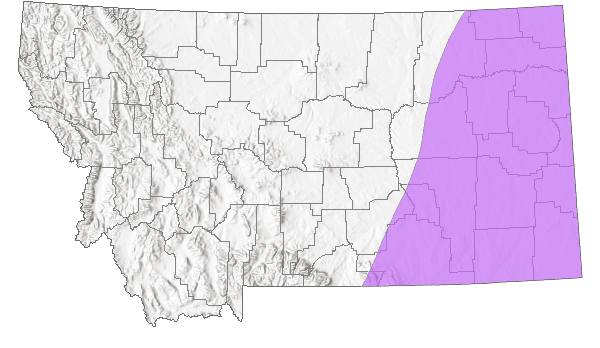
 Native
Native
Range Comments
SK to ON south to NM, TX, TN and NC (Lesica et al. 2012. Manual of Montana Vascular Plants. BRIT Press. Fort Worth, TX).
Observations in Montana Natural Heritage Program Database
Number of Observations: 201
(Click on the following maps and charts to see full sized version)
Map Help and Descriptions
Relative Density
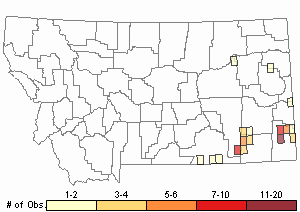
Recency
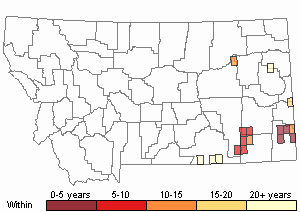

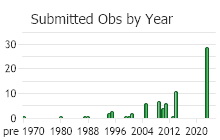
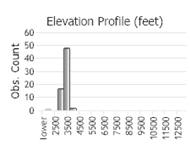 (Observations spanning multiple months or years are excluded from time charts)
(Observations spanning multiple months or years are excluded from time charts)
Habitat
Heavy sedge is widespread in moist prairie and woodlands in the eastern U.S., but is known only from easternmost Montana, where most localities are in green ash ravines and wooded draws.
In Powder River and Rosebud counties, heavy sedge grows deep in woody draws under green ash and tall shrub thickets of serviceberry, quaking aspen, and chokecherry. Other associates include Apocynum androsaemifolium, Carex hoodii, Carex sprengelii, Carex torreyi, Crataegus columbiana, Fraxinus pennsylvanica, Poa interior, Poa pratensis, Rosa woodsii, Sanicula marilandica, Symphoricarpos occidentalis and Viola canadensis.
In Bighorn Canyon, C. gravida grows along Black Canyon Creek, a perennial coldwater stream with an overstory of ponderosa pine, and chokecherry in the understory. Associates there include Agrimonia striata and Toxicodendron rydbergii.
National Vegetation Classification System Groups Associated with this Species
Forest and Woodland
Deciduous Forest and Woodland
Wetland and Riparian
Riparian and Wetland Forest
Ecology
Montana populations usually occur in green ash woodlands of ravines and ephemeral drainages. Soils are well-drained loams with deep profiles compared to those on adjoining slopes. Silty alluvium had washed into one site, but there was no apparent surface runoff.
This is a perennial plant that forms large tussocks that may be very long-lived. However, seed production is the only means of establishing new individuals and colonies.
Management
Green ash woodlands are vulnerable to livestock grazing and invasive exotic plant encroachment (Lesica 1989, 2001), and many of these woodlands are in a degraded condition (Lesica 2001). They are often heavily utilized by cattle because of the shade and productive vegetation. Carex gravida likely declines with grazing, since the closely related C. hoodii is known to be palatable to livestock and is reported to decrease with grazing (Hermann 1970).
Weeds pose a serious threat to heavy sedge, with exotic grasses and leafy spurge having invaded many green ash woodlands. Rhizomatous exotic grasses such as Poa pratensis and Bromus inermis can also out-compete many native cespitose graminoids.
Stewardship Responsibility
Threats or Limiting Factors
STATE THREAT SCORE REASON
Reported threats to Montana's populations of Heavy Sedge include competition from noxious and non-native species and relatively severe grazing and trampling damage by livestock. Many populations are in the vicinity of rangeland that has been converted to exotic grasses and noxious weeds, primarily Leafy Spurge (Euphorbia virgata). Heavy sedge is palatable to livestock, and occurs in woody draws where livestock tend to congregate and inflict more severe disturbance. Repeated grazing and trampling results in mortality of individuals, and is likely to promote the spread of non-native plants. Impacts are likely to be more severe where non-native plants and livestock co-occur (MTNHP Threat Assessment 2021).
References
- Literature Cited AboveLegend:
 View Online Publication
View Online Publication Lesica, P., M.T. Lavin, and P.F. Stickney. 2012. Manual of Montana Vascular Plants. Fort Worth, TX: BRIT Press. viii + 771 p.
Lesica, P., M.T. Lavin, and P.F. Stickney. 2012. Manual of Montana Vascular Plants. Fort Worth, TX: BRIT Press. viii + 771 p. MTNHP Threat Assessment. 2021. State Threat Score Assignment and Assessment of Reported Threats from 2006 to 2021 for State-listed Vascular Plants. Botany Program, Montana Natural Heritage Program, Helena, Montana.
MTNHP Threat Assessment. 2021. State Threat Score Assignment and Assessment of Reported Threats from 2006 to 2021 for State-listed Vascular Plants. Botany Program, Montana Natural Heritage Program, Helena, Montana.
- Additional ReferencesLegend:
 View Online Publication
View Online Publication
Do you know of a citation we're missing? Heidel, B.L. and H. Marriott. 1996. Sensitive plant species survey of the Ashland District, Custer National Forest, Powder River and Rosebud Counties, Montana. Unpublished report to the U.S. Forest Service. Montana Natural Heritage Program, Helena, Montana. 94 pp. plus appendices.
Heidel, B.L. and H. Marriott. 1996. Sensitive plant species survey of the Ashland District, Custer National Forest, Powder River and Rosebud Counties, Montana. Unpublished report to the U.S. Forest Service. Montana Natural Heritage Program, Helena, Montana. 94 pp. plus appendices. Hermann, F. J. 1970. Manual of the Carices of the Rocky Mountains and Colorado Basin. Agricultural Handbook No. 374. USDA Forest Service. 397 pp.
Hermann, F. J. 1970. Manual of the Carices of the Rocky Mountains and Colorado Basin. Agricultural Handbook No. 374. USDA Forest Service. 397 pp. Lesica, P. 1989. The vegetation and condition of upland hardwood forests in eastern Montana. Proc. Mont. Acad. Sci., 49:45-62. Env. Sci. and Eng.
Lesica, P. 1989. The vegetation and condition of upland hardwood forests in eastern Montana. Proc. Mont. Acad. Sci., 49:45-62. Env. Sci. and Eng. Lesica, P. 2001. Ecology and Management of green ash woodlands in eastern Montana. Unpublished report to the Bureau of Land Management, Miles City, Montana.
Lesica, P. 2001. Ecology and Management of green ash woodlands in eastern Montana. Unpublished report to the Bureau of Land Management, Miles City, Montana. Lesica, P. 2001. Recruitment of Faxinus pennsylvanica (Oleaceae) in Eastern Montana Woodlands. Madrono 48(4):286-292.
Lesica, P. 2001. Recruitment of Faxinus pennsylvanica (Oleaceae) in Eastern Montana Woodlands. Madrono 48(4):286-292. Lesica, P., M.T. Lavin, and P.F. Stickney. 2022. Manual of Montana Vascular Plants, Second Edition. Fort Worth, TX: BRIT Press. viii + 779 p.
Lesica, P., M.T. Lavin, and P.F. Stickney. 2022. Manual of Montana Vascular Plants, Second Edition. Fort Worth, TX: BRIT Press. viii + 779 p.
- Web Search Engines for Articles on "Heavy Sedge"





